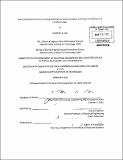| dc.description.abstract | In this thesis, we present a complete set of techniques for sub-femtosecond measurement, control and distribution of ultrafast optical pulse trains, with respect to pulse timing and phase. First, analytical analysis of the balanced optical cross-correlator (BOC) for attosecond precision pulse timing measurement is presented for both short and long crystal devices. It is found that the sensitivity of the long crystal BOC is independent of pulse duration, to first order. In addition, analytical noise models predict 13 as rms resolution, within a 1 MHz bandwidth, for optical pulses consistent with a practical fiber optic timing link. This analysis aids the widespread adoption of the BOC technique for other wavelengths and implementations. Secondly, long term timing distribution of a 200 MHz ultrafast optical pulse train over 340 m of single mode optical fiber is demonstrated, using the BOC. In this way, the group delay of the fiber link is directly stabilized with unprecedented precision and longterm stability. In addition, by distributing the entire optical pulse train, all optical and RF harmonics are provided at the remote location for direct synchronization of remote ultrafast lasers and microwave electronics. Over 168 hours of continuous, unaided operation, a drift of 5 fs rms is achieved, with less than 1.5 fs rms drift at timescales up to 10,000 seconds. Additional analysis of factors effecting performance, such as polarization mode dispersion and fiber nonlinearity is studied through experiment and simulations. It is found that nonlinear-origin drifts can be avoided for pulse energies below 40 pJ. A chirped pulse method could be implemented to distribute pulses of higher energy. Thirdly, the first quantum-resolution timing jitter measurement of ultrafast laser timing jitter for passively mode-locked lasers up to the Nyquist frequency is presented. The total jitter from for a 79.4 MHz stretched pulse erbium fiber laser is found to be 2.6 fs rms [10 kHz, 39.7 MHz]. It is found that the timing jitter power spectral density scales with frequency according to that expected for a white noise source, in agreement with theory. However, unexpected spurious jitter at high frequencies can occur for some mode-locked states, adding up to 5.5 fs rms jitter. Similar measurements of a 200 MHz erbium fiber soliton laser reveal the decay time of center frequency fluctuations to be 17 ns, with a predicted excess noise of approximately ten. These measurements suggest that timing jitter can be decreased through improved amplifier design. Finally, the synchronization of a 8 fs fiber supercontinuum at 1200 nm to a 7 fs Ti:Sapphire laser pulse train at 800 nm is achieved for both pulse timing and phase with attosecond precision. This achievement is enabled by the development of a novel scheme for stabilization of the carrier envelope offset of the entire optical bandwidth of an octave spanning supercontinuum, without introducing excess timing jitter. In particular, by implementing an acousto-optic frequency shifting (AOFS) feedback system within a fiber supercontinuum source, carrier envelope phase locking, to the Ti:Sapphire laser, is demonstrated to within 200 mrad rms [100 Hz, 5 MHz]. Previous techniques lack the high-speed, orthogonal control of CEP and pulse timing and broad optical bandwidth for synthesizing few-cycle optical pulses. Furthermore, timing synchronization of 280 as rms is achieved through combined piezoelectric and electro-optic feedback on the fiber supercontinuum, as measured with the BOC. This work enables the synthesis of a frequency comb spanning 650 to 1400 nm, resulting in a 3.5 fs transform limited pulse duration-assuming ideal spectral phase compression. To date, the spectrum has been successfully compressed to 4.7 fs, as measured with two-dimensional spectral shearing interferometry (2DSI). Moreover, by stabilizing a fiber supercontinuum source to a low-noise Ti:Sapphire laser, the ultra-high stability of the Ti:Sapphire laser is fully transferred to the octave spanning supercontinuum. | en_US |
